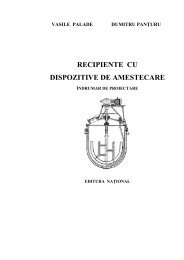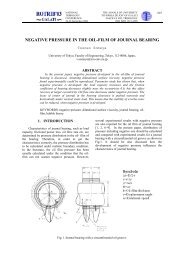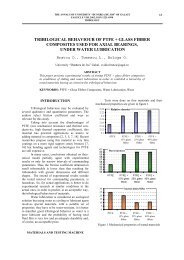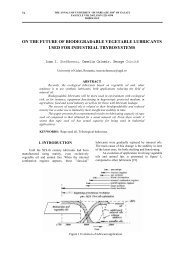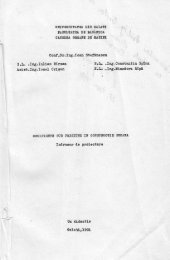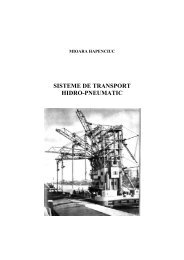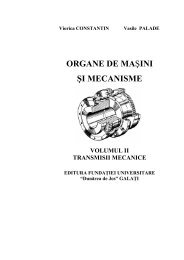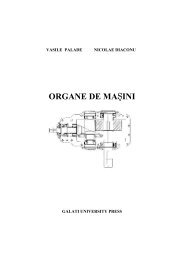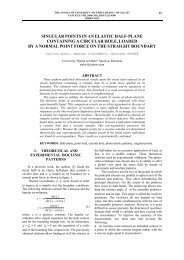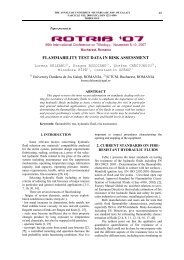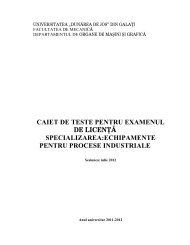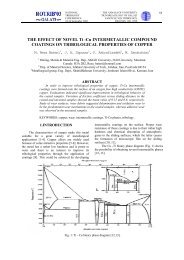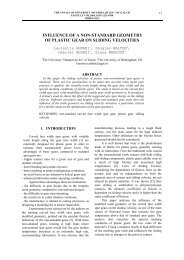ultrasound action on strength properties of polycrystalline metals
ultrasound action on strength properties of polycrystalline metals
ultrasound action on strength properties of polycrystalline metals
You also want an ePaper? Increase the reach of your titles
YUMPU automatically turns print PDFs into web optimized ePapers that Google loves.
THE ANNALS OF UNIVERSITY “DUNĂREA DE JOS “ OF GALAŢI<br />
FASCICLE VIII, 2006 (XII), ISSN 1221-4590<br />
TRIBOLOGY<br />
75<br />
Without<br />
<str<strong>on</strong>g>ultrasound</str<strong>on</strong>g><br />
With<br />
<str<strong>on</strong>g>ultrasound</str<strong>on</strong>g><br />
Table 2. Hardness test values (HB)<br />
1 2 3 4 5<br />
21.8 21.8 22.0 22.2 22.3<br />
28.0 27.9 28.2 28.2 28.0<br />
It is known that grain boundaries could act as<br />
barriers to dislocati<strong>on</strong> moti<strong>on</strong>, but we also viewed a<br />
grain boundary as a sort <strong>of</strong> "film". If the <strong>properties</strong> <strong>of</strong><br />
the grain boundary were known then a more complete<br />
analysis <strong>of</strong> their <strong>strength</strong>ening effect could be made.<br />
Grain boundaries are simply planar defects between<br />
adjacent grains, each grain having different<br />
crystallographic orientati<strong>on</strong>s. Low angle grain<br />
boundaries occur when the miss-orientati<strong>on</strong> <strong>of</strong> the<br />
lattices <strong>of</strong> adjacent grains is less than 15°. These<br />
boundaries can be modeled as an array <strong>of</strong> edge<br />
dislocati<strong>on</strong>s. The structure <strong>of</strong> high angle grain<br />
boundaries is more complex. The other characteristics<br />
<strong>of</strong> grain boundaries are that they tend to attract<br />
impurities. In a sense, this might be thought <strong>of</strong> as a<br />
film which can either <strong>strength</strong>en or weaken a<br />
material. Grain boundary segregati<strong>on</strong> <strong>of</strong> impurities,<br />
however, does not always embrittle a material [9].<br />
Grain boundaries are lattice imperfecti<strong>on</strong>s and<br />
as such increase the free energy <strong>of</strong> the material. There<br />
is a tendency to minimize the c<strong>on</strong>tributi<strong>on</strong> from grain<br />
boundaries and this involves reducing the grain<br />
boundary area to grain volume ratio, something<br />
which happens as the grains grow larger. While other<br />
factors can cause grains to grow, this is essentially the<br />
process involved in normal grain growth (also called<br />
ideal grain growth). N<strong>on</strong>-ideal grain growth occurs<br />
when grain growth is inhibited by the presence <strong>of</strong> a<br />
sec<strong>on</strong>d phase or is restricted by the edges <strong>of</strong> the<br />
specimen. Ultras<strong>on</strong>ic <str<strong>on</strong>g>acti<strong>on</strong></str<strong>on</strong>g>, cold work, pressure,<br />
magnetic fields, etc. also cause grain growth to<br />
deviate from the ideal case.<br />
The effect <strong>of</strong> grain size <strong>on</strong> the hardness<br />
<strong>properties</strong> <strong>of</strong> <strong>polycrystalline</strong> <strong>metals</strong> c<strong>on</strong>sists in<br />
increasing <strong>of</strong> hardness for the sample with finegrained<br />
structure. It is suggested that this morphology<br />
<strong>of</strong> ingot solidified in ultras<strong>on</strong>ic filed results from<br />
increased growth rate and smaller crystallite size. So,<br />
reducing the grain size <strong>of</strong> a <strong>polycrystalline</strong> material is<br />
an effective way <strong>of</strong> increasing its <strong>strength</strong> [4].<br />
Under ultras<strong>on</strong>ic c<strong>on</strong>diti<strong>on</strong>s, the acoustic flow<br />
takes place in the liquid metal. It is clearly<br />
dem<strong>on</strong>strated that the acoustic flows are associated<br />
with the <str<strong>on</strong>g>ultrasound</str<strong>on</strong>g> absorpti<strong>on</strong>, whatever its nature.<br />
However, the absorpti<strong>on</strong> coefficient is quite small for<br />
the liquid <strong>metals</strong>, so the increase in the temperature <strong>of</strong><br />
the melt caused by absorpti<strong>on</strong> process has been<br />
eliminated. In these c<strong>on</strong>diti<strong>on</strong>s, the reas<strong>on</strong> for this<br />
prominent change in solidificati<strong>on</strong> kinetic is assumed<br />
to be large-scale acoustic streaming. Its effect is a<br />
permanent stirring <strong>of</strong> the melt so the effects <strong>of</strong><br />
thermal and mass homogeneity <strong>of</strong> the melt are quite<br />
obvious [3]. The increasing in the intensity <strong>of</strong> fluid<br />
flow can give rise to grain multiplicati<strong>on</strong>, which can<br />
be attributed to the increased effective nucleati<strong>on</strong> rate<br />
caused by the extremely uniform temperature and<br />
compositi<strong>on</strong> fields in the bulk liquid at early stages <strong>of</strong><br />
solidificati<strong>on</strong>. Also, the forced c<strong>on</strong>vecti<strong>on</strong> increases<br />
the growth rate. The solidificati<strong>on</strong> starts by<br />
heterogeneous nucleati<strong>on</strong> at the crucible wall through<br />
the so- called “big-bang” mechanism. Only a fr<str<strong>on</strong>g>acti<strong>on</strong></str<strong>on</strong>g><br />
<strong>of</strong> the nuclei formed at this stage c<strong>on</strong>tributed to the<br />
formati<strong>on</strong> <strong>of</strong> the chilled z<strong>on</strong>e and the majority <strong>of</strong> the<br />
nuclei are transferred into the hotter bulk liquid and<br />
remelted. The final solidified microstructure depends<br />
largely <strong>on</strong> the amount <strong>of</strong> nuclei surviving after the<br />
big-bang nucleati<strong>on</strong>. Under the <str<strong>on</strong>g>ultrasound</str<strong>on</strong>g> <str<strong>on</strong>g>acti<strong>on</strong></str<strong>on</strong>g> both<br />
the temperature and compositi<strong>on</strong> fields <strong>of</strong> the liquid<br />
metal are extremely uniform. The nuclei formed will<br />
survive due to the uniform temperature field,<br />
resulting in an increased effective nucleati<strong>on</strong> rate. In<br />
additi<strong>on</strong>, the intensive stirring may also disperse the<br />
cluster <strong>of</strong> potential nucleati<strong>on</strong> agents, giving rise to an<br />
increased number <strong>of</strong> potential nucleati<strong>on</strong> sites. Also,<br />
under forced c<strong>on</strong>vecti<strong>on</strong>, the nucleati<strong>on</strong> and the<br />
growth at the chilled wall were suppressed, while the<br />
nucleati<strong>on</strong> and growth in the bulk liquid were<br />
enhanced [1].<br />
It has been suggested that the forced c<strong>on</strong>vector<br />
fluid flow induced by <str<strong>on</strong>g>ultrasound</str<strong>on</strong>g> may be sufficient to<br />
break small dendrite arms and distribute them<br />
throughout the melt. If a high energy boundary is<br />
formed in a metal in c<strong>on</strong>tact with its liquid then the<br />
c<strong>on</strong>diti<strong>on</strong> indicates that the grain boundary will be<br />
wetted by the liquid phase, i.e. replaced by a thin<br />
layer <strong>of</strong> liquid and thus the dendrites break appear.<br />
Further these broken dendrites act as nucleants and<br />
grow as globular n<strong>on</strong>dendrite structures. The acoustic<br />
streaming produced the change in possibility that<br />
hydrodynamic force to cause breakage <strong>of</strong> dendritic<br />
arms under the solidificati<strong>on</strong> c<strong>on</strong>diti<strong>on</strong>s. In the same<br />
time, due to supplementary energy c<strong>on</strong>tributi<strong>on</strong>, the<br />
ultras<strong>on</strong>ic field presence hinders the l<strong>on</strong>g-range<br />
ordering processes <strong>of</strong> atoms. At this moment, they act<br />
as nuclei for the growth <strong>of</strong> more particles and the<br />
relatively small dendrite spacing are created.<br />
The possibility that fluid flow could disrupt the<br />
crystal b<strong>on</strong>ding is also c<strong>on</strong>sidered [5]. The shear<br />
forces resulting from natural c<strong>on</strong>vecti<strong>on</strong> flow <strong>of</strong> the<br />
melt are too weak to disrupt the crystal b<strong>on</strong>ding<br />
during solidificati<strong>on</strong>. However under ultras<strong>on</strong>ic field,<br />
these forces are dramatically increasing. The accuracy<br />
<strong>of</strong> s<strong>on</strong>ic measurements is reas<strong>on</strong>able taking into<br />
account the difficulties associated with getting the<br />
<str<strong>on</strong>g>ultrasound</str<strong>on</strong>g> into the melted metal.<br />
The ultras<strong>on</strong>ic field presence into a liquid<br />
causes cavitati<strong>on</strong> phenomen<strong>on</strong> [1]. This imposes a<br />
sinusoidal variati<strong>on</strong> in pressure <strong>on</strong> a steady state<br />
ambient pressure. One new questi<strong>on</strong> <strong>of</strong> this study is<br />
the problem <strong>of</strong> cavitati<strong>on</strong> and its microstreaming<br />
effect. The effect <strong>of</strong> <str<strong>on</strong>g>ultrasound</str<strong>on</strong>g> increases with<br />
increasing power, but not indefinitely since there is an<br />
optimum value bey<strong>on</strong>d which the effect diminishes.



